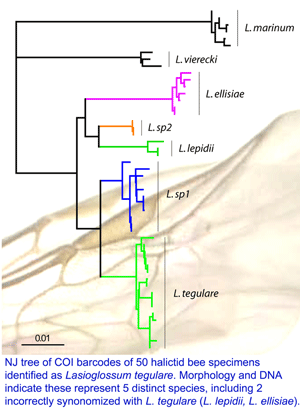 On 15 may 2008 an international assembly of bee experts gathered at York University and announced a new initiative to DNA barcode world’s bees. Some snippets from news reports:
On 15 may 2008 an international assembly of bee experts gathered at York University and announced a new initiative to DNA barcode world’s bees. Some snippets from news reports:
“According to York biology professor Laurence Packer, who’s leading the group’s efforts, precisely 19,231 different kinds of bees have been identified. But he thinks there might be another 5,000 or more species out there waiting.” (Toronto Star)
“There are two reasons why bee species would benefit from a barcode name tag. “Most of the specimens in museums are not identified, and the ones that are identified are only 60 to 70 percent correctly identified,” says Dr. Packer.” (University Affairs)
Early results, as in figure from poster at right, suggest that DNA barcoding will help sort out bee taxonomy and speed discovery of new species, with benefits to society and science. Bees are essential pollinators for many of the world’s plants, including many endangered species, and approximately 1/3 of world’s food is derived directly or indirectly from bee-pollinated plants.
In common with other Hymenoptera (bees, wasps, ants), bees exhibit haplodiploidy (males haploid, females diploid), many species are eusocial (live in large colonies with single queens), and have greatly accelerated rates of mitochondrial evolution. Are these factors causally linked? Looking at differences among and within world’s bees may help provide fundamental insight into mitochondrial biology and evolution.
Bees are so important for for so many of the plants we take for granted and not just the honey bees. Native bees are also vital for the survival of our native plants as well as genetic diversity. It’s really exciting to see that bees as a whole will included in this project.